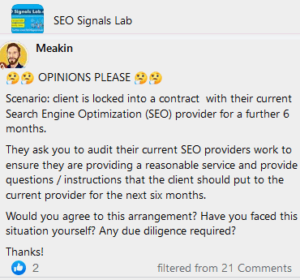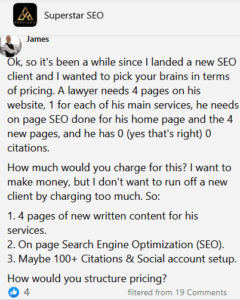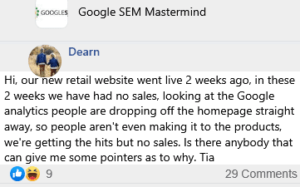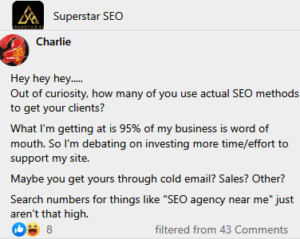John
Hey guys, I've been asking a lot in this group lately, so this time I'm giving back. I wanted to share how I go about ranking pages on behalf of clients.
1. The first thing I do is ask the client where they want me to focus my efforts. In other words, "what area of the business do you want me to focus on? Which product/service do you really want to push?" Typically the answer to this ties in against earning potential. For eg, a client might respond and say "I'd like you to focus on helping us sell more blue widgets, because each time we sell one of those, we make $7,000". Very rarely do I ever talk about keywords during this discussion. I don't want the client worrying about keywords. That's for me to worry about, not them. I don't want to start that bullshit where a client becomes fixated on stupid shit. I want to keep the discussion with the client business related.
2. Once I understand which product/service the client wants me to focus on, I figure out whether or not that needs to be a core page, or a blog post. In most cases, its a core page, (product/service page) but in almost every case, I supplement that core page by building out a lot of highly relevant blog post content that focuses on the same subject matter. That might mean creating dozens of blog posts around blue widgets. Of course any blog posts that cover the same/similar subject matter I link back to the core page. Internal linking *might help* in terms of rankings, but its more so there to drive traffic back to the core page in an effort to increase conversions.
3. Now that I know the client wants to focus on blue widgets, I will figure out what the primary keyword is for blue widgets (where the most search volume is) I use keyword.com here and also SEMrush. Finding the primary keyword, and other related keywords of interest is easy. I build out a solid core page and optimise the shit out of it. Good onpage, with long form content with depth, will help do a lot of the heavy lifting for you, which means less work in terms of offpage. Kyle said it perfectly during a recent interview, he said "If you've got solid onpage, that will often mean having to build fewer links in order to rank the page" and that is definitely true.
4. Once the page is built out, I then go to Google and copy down the first several sites that are ranking first page in Google for the primary keyword I identified and paste the URls into notepad. I then take those URls and paste them into Ahrefs and note down all of the backlink anchors used. So as an example, if I was targeting, blue widgets, I might end up with a list like
the best blue widgets
blue widgets for everyday use
best blue widgets
widget blue
affordable blue widgets
widgets that are blue
blue colored widgets by bluewidgets.com
express blue widgets
discover blue widget
light blue in color widget
…and so on
5. I'll then add these anchors to my offpage optimisation spreadsheet that I host on Google Drive and use them to help guide me in terms of which anchors to use when linking back to the core page I created. My team create content that is usually 650 words in length, and is of course highly relevant. Obviously I add the anchors I've identified above within the content. That content gets published on highly relevant sites with decent DA and traffic. Most importantly of all, the sites are relevant and selective about the content they publish.
6. I then continue this cycle, usually publishing 4 or 5 articles per billing cycle, and watch the page move up over time.
A few keynotes of importance –
1. I don't continually slam the same page constantly over and over. I might create 5 pieces of content, but only push 4 at the target core page, and one at a random blog post using any anchor. I do this because I want inlinks to look natural
2. Diversity is essential. You want your anchors and links to look natural. This is whats great about reverse engineering existing anchors, because its so diverse.
3. I don't bounce around all over the place month to month targeting different shit. I make this clear with the client. "Lets focus our efforts on this, and once we've accomplished that, then lets look at another product/service". Sometimes it takes 8-12 weeks or more before pages actually move to where you want them to. You cant be focusing on new pages/products/services every 5 minutes.
4. The objective is for the client to say, "Hey, were selling a shit load of blue widgets, this month we sold $100,000 worth, this is fantastic". Not knowing they're actually ranking for dozens of keyword variations for the term blue widgets, and NOT being fixated on one stupid f*cking keyword. You never want to get into that discussion with a client. Its exhausting.
That's pretty much it. Its nothing fancy but it works. Hopefully I haven't missed anything.
PS – To clarify, I focus on revenue, not rankings with clients.
Hope everyone is well.
76 👍🏽 19 💟 95
[filtered from 25 Answers]
This is good stuff, thanks John!
I'm guessing you're not doing any 'manual outreach' 😉
Ha, no mate, my team does all that
Stephen
John, where would your time be better spent, or put another way, which would be more effective…writing dozens of 650 word blog posts on Blue widgets, or writing THE definitive blog post on Blue Widgets?
Neither. My team does all that. The only thing I do is inject the appropriate anchors in the content before passing it over to my offpage team.
Oberg
Get the KPIs that matter to them. Learn their business and eventually, you can even suggest other advertising angles. Smart marketers ask the right questions and know when to advise the data is saying something else it makes you more valuable. Great post John.
Thank you dude
Noah Lopata 🎓
Solid post.
We do pretty much the same.
Appreciate the attention to not letting the client to get focused on non-relevant data points.
Cheers thank you
Lincoln
Great post John
I have a question: do you ever get clients who ask more about what happens behind the curtain? Like what you do for an ongoing basis (I'm assuming you charge a retainer).
They don't need to. I provide them with an end of month work summary sheet that outlines all of the work completed.
I charge hourly tied in as a monthly retainer. $165ph, minimum 15 hours or $2500 pm
This may satisfy you: A Client has got the ROI and Great Sales | the Site Already Rank for Most Of the Keywords in the Top 5 Positions | the Client Wants to Cut My Services | No Contracts





